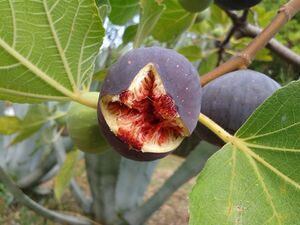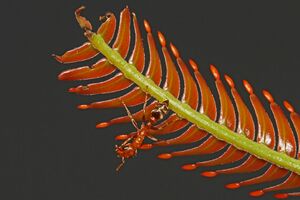共同演化
Fig reproduction and fig wasps

The genus Ficus is composed of 800 species of vines, shrubs, and trees, including the cultivated fig, defined by their syconiums, the fruit-like vessels that either hold female flowers or pollen on the inside. Each fig species has its own fig wasp which (in most cases) pollinates the fig, so a tight mutual dependence has evolved and persisted throughout the genus.[1]
The genus Ficus is composed of 800 species of vines, shrubs, and trees, including the cultivated fig, defined by their syconiums, the fruit-like vessels that either hold female flowers or pollen on the inside. Each fig species has its own fig wasp which (in most cases) pollinates the fig, so a tight mutual dependence has evolved and persisted throughout the genus.
榕属植物由800种藤本植物、灌木和乔木组成,其中包括栽培的无花果。每一种榕树都有自己的榕小蜂(在大多数情况下)为榕小蜂授粉,所以这个属中形成了一种紧密的相互依赖关系。

- ↑ 1.0 1.1 Suleman, Nazia; Sait, Steve; Compton, Stephen G. (2015). "Female figs as traps: Their impact on the dynamics of an experimental fig tree-pollinator-parasitoid community" (PDF). Acta Oecologica. 62: 1–9. Bibcode:2015AcO....62....1S. doi:10.1016/j.actao.2014.11.001.
- ↑ 引用错误:无效
<ref>标签;未给name属性为Hölldobler-532的引用提供文字